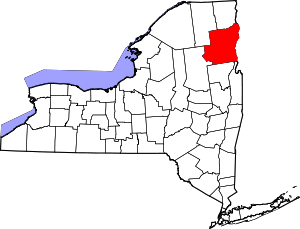Saranac Lake, New York
Saranac Lake is a village in the state of New York, United States. As of the 2010 census, the population was 5,406.[3] The village is named after Upper, Middle and Lower Saranac lakes, which are nearby.
Saranac Lake, New York | |
|---|---|
Village | |
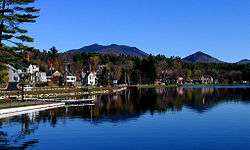 Lake Flower, from Riverside Park | |
| Nickname(s): The Capital of the Adirondacks | |
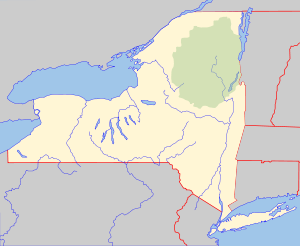 Saranac Lake Location in the state of New York | |
| Coordinates: 44°19′34″N 74°7′51″W | |
| Country | United States |
| State | New York |
| Counties | Franklin, Essex |
| Towns | Harrietstown, North Elba, St. Armand |
| Government | |
| • Type | Mayor and Board of Trustees |
| • Mayor | Clyde Rabideau |
| Area | |
| • Total | 3.15 sq mi (8.15 km2) |
| • Land | 2.90 sq mi (7.50 km2) |
| • Water | 0.25 sq mi (0.64 km2) |
| Elevation | 1,545 ft (471 m) |
| Population (2010) | |
| • Total | 5,406 |
| • Estimate (2019)[2] | 5,200 |
| • Density | 1,794.96/sq mi (693.01/km2) |
| Time zone | UTC−5 (Eastern (EST)) |
| • Summer (DST) | UTC−4 (EDT) |
| ZIP Code | 12983 |
| Area code(s) | 518 Exchanges: 891.897 |
| FIPS code | 36-65233 |
| GNIS feature ID | 0964482 |
| Website | www |
The village of Saranac Lake covers parts of three towns (Harrietstown, St. Armand, and North Elba) and two counties (Franklin and Essex). The county line is within two blocks of the center of the village. At the 2010 census, 3,897 village residents lived in Harrietstown,[4] 1,367 lived in North Elba,[5] and 142 lived in St. Armand.[6] The village boundaries do not touch the shores of any of the three Saranac Lakes; Lower Saranac Lake, the nearest, is a half mile west of the village. The northern reaches of Lake Flower, which is a wide part of the Saranac River downstream from the three Saranac Lakes, lie within the village. The town of Saranac is an entirely separate entity, 33 miles (53 km) down the Saranac River to the northeast.
The village lies within the boundaries of the Adirondack Park, 9 miles (14 km) west of Lake Placid. These two villages, along with nearby Tupper Lake, comprise what is known as the Tri-Lakes region.
Saranac Lake was named the best small town in New York State and ranked 11th in the United States in The 100 Best Small Towns in America.[7] In 1998, the National Civic League named Saranac Lake an All-America City, and in 2006 the village was named one of the "Dozen Distinctive Destinations" by the National Trust for Historic Preservation.[8] 186 buildings in the village are listed on the National Register of Historic Places.
History
This area was occupied by Iroquoian-speaking peoples for hundreds of years, and by other Indigenous peoples before them. The historic Mohawk people extended their hunting grounds to this area.
The area was first settled by European Americans in 1819, more than three decades after the American Revolutionary War. As the Iroquois, mostly allies of the British, had been forced to cede their land to the United States following the war, millions of acres of New York were opened up to non-Native development in the postwar period.
The Jacob Smith Moody family from Keene, New Hampshire was the first to settle here. In 1827, settlers Pliny Miller and Alric Bushnell established a logging facility with a dam and sawmill, around which the village developed. The first school was built in 1838. In 1849, William F. Martin built one of the first hotels in the Adirondack Mountains. His Saranac Lake House, known simply as "Martin's", was located on the southeast shore of Lower Saranac Lake. Martin's soon became a favorite place for hunters, woodsmen, and socialites to meet and interact.

In 1876, Dr. Edward Livingston Trudeau arrived from New York City to treat his tuberculosis (TB) by a stay in the mountains. There was no medical treatment other than rest and nutrition at the time, and the disease was often fatal. Dry, cold air was considered to be good for patients, and sanitariums were also founded in European mountain resorts. Trudeau discovered that the fresh air and dry, alpine climate improved his health. In 1884, he founded his Adirondack Cottage Sanitarium, starting with a small cottage, called "Little Red". Two sisters from New York City who suffered from TB became the first patients. Little Red, the first "cure cottage", was built on a small patch of land on the north side of Mount Pisgah. The plot had been purchased for Trudeau by several of his hunting guides.
As more patients visited the region, including author Robert Louis Stevenson in 1887, Trudeau's fame grew.[9] Soon, the sanitarium had grown to such size that it was entitled to its own post office, which delivered mail to the many patients. The Trudeau Institute, an independent medical research center, developed from Trudeau's work for the sanitarium. In 1964, the Trudeau Institute began researching the functions of the immune system and how it guards against many infectious diseases, including tuberculosis.
William S. Fowler was a real estate speculator and developer who owned several properties around Saranac Lake. One was a large property just outside the town on top of a hill. He named it "Spion Kop" in honor of a battle that was fought in the Boer War in South Africa. In commemoration he placed miniature cannons on various parts of the property.
Several buildings were erected as cottages where people could "cure" from TB. In 1919, Fowler sold the property to the Northwestern Fire Insurance Company. They turned it into a private sanatorium for their employees.
In 1925, the sanatorium was sold to the National Vaudeville Artists. Around this time there were numerous vaudeville performers in Saranac Lake seeking cures at different locations. E. F. Albee, the owner and President of the National Vaudeville Artists held benefit programs in New York City to raise funds to construct the large sanitarium. The older cure cottages were torn down and some were moved. By the end of the 1920s, the Tudor Building was completed. It still stands today.
In the 1930s the National Vaudeville Artists no longer existed. Antibiotics were used to treat TB, and the mountain sanitariums were converted to other uses. The Tudor Building was purchased by the Will Rogers Memorial Commission. In 1936, one year after Rogers' death, they renamed this building as the Will Rogers Memorial Hospital. A laboratory was built in later years and named the O'Donnell Memorial Laboratory in honor of R.J. O'Donnell, a well-known theater chain manager.
In the 1970s, New York State forced the closure of the hospital, as it did not meet contemporary codes and updating was cost-prohibitive. The Will Rogers building was adapted for other uses. It was operated as a night club, then as a timeshare vacation spot, and finally as apartments. Unable to attract enough renters, the owners abandoned the property, which deteriorated. In 1980, it was renovated for use as the press headquarters for the Winter Olympics. In 1995, the Kaplan Development Group purchased the property for adaptation as a retirement home for senior residents. It planned to restore the building's historic details.
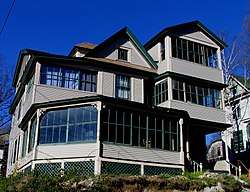
Telephone service was introduced in 1884, and the Chateaugay branch of the Delaware and Hudson Railroad reached Saranac Lake from Plattsburgh in 1887. The railroads both carried passenger traffic to the growing resort areas of the Adirondacks, and shipped out the millions of feet of lumber that were harvested from this area into the early 20th century.
The village was incorporated on June 16, 1892, and Dr. Trudeau was elected the first village president soon thereafter. Electricity was introduced on September 20, 1894, by installing water wheels on the former site of Pliny Miller's mill. Paul Smith purchased the Saranac Lake Electricity Co. in 1907, and formed the Paul Smith's Electric Light and Power and Railroad Company. It eventually became part of Niagara-Mohawk. At the same time, the village began to develop municipal facilities, such as public schools, and fire and police departments.
In 1892, John Rudolphus Booth, the Canadian lumber king, rented a cottage at Saranac Lake for his daughter, who used it for several years in seeking a TB cure. Booth brought skis with him, and introduced the sport of skiing to the area.[10]
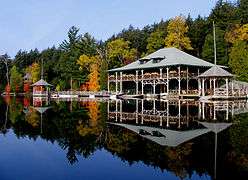
Starting in the 1890s and for the next 60 years, Saranac Lake was known as "the Western Hemisphere's foremost center for the treatment of pulmonary tuberculosis".[11] An effective antibiotic was first used on human TB patients in 1921, but only after World War II did it begin to be widely used in the US. In the postwar period, sanatorium treatment became less important and was phased out completely by 1954. Among the last of the prominent patients who sought treatment for tuberculosis was Manuel Luis Quezon y Molina, the first Filipino president of the Commonwealth of the Philippines, who died in Saranac Lake of the disease on August 1, 1944.
But the village had become a center of tuberculosis care, attracting many doctors and patients from around the world. They added to and supported the culture of the area, as did the wealthy who built Great Camps on the nearby Saranac and Saint Regis Lakes, the effect was to change the sleepy village of 300 of the 1880s into the vibrant "little city" of 8,000.[12]

Author Mark Twain vacationed on Lake Flower in 1901[14] at the height of his fame. While there, he wrote a Conan Doyle spoof, "A Double-Barreled Detective Story".[15]
After multiple fires destroyed a large part of downtown, Saranac Lake rebuilt in the 1920s. The Hotel Saranac was built in the Art Deco style and still stands. Other permanent buildings were added to the townscape. During the Prohibition era, rum-running was common in the village, as smugglers brought liquor from over the border from Canada. Gangster Legs Diamond visited his brother Eddy, who had TB and stayed at a local cottage sanatorium.[15] During the 1920s, entertainer Al Jolson and president Calvin Coolidge were semi-frequent visitors to the village; Jolson once performed a solo for three hours at the Pontiac Theater on Broadway.
Beginning in 1936, physicist Albert Einstein had a summer home in Saranac Lake, renting the cottage of local architect William L. Distin; he often sailed with his wife on Lake Flower.[15] During World War II, Einstein summered frequently at Knollwood Club on Lower Saranac Lake. He heard with others from the radio that on August 6, 1945 the atom bomb had been dropped on Hiroshima. A few days later, Einstein gave his first interview about this event at Knollwood.[15]
In 1954, Saranac Lake hosted the world premiere of the Biblical epic film The Silver Chalice, in which actor Paul Newman made his debut. Several of the stars, including Virginia Mayo, visited the village and participated in the winter carnival parade.
Since the late 20th century, Saranac Lake has become a more conventional tourist destination. New York's governor, Andrew Cuomo, has visited there ever since he was a teenager and regularly vacations there with his family.[16] The Hotel Saranac is a memorable early 20th century Art Deco structure. The former sanatorium is now used as the corporate call center for the American Management Association.
Numerous properties are listed on the National Register of Historic Places: the Dr. A. H. Allen Cottage, Berkeley Square Historic District, Bogie Cottage, Peyton Clark Cottage, Coulter Cottage, Cure Cottage at 43 Forest Hill Avenue, Denny Cottage, Fallon Cottage Annex, Freer Cottage, Hathaway Cottage, Helen Hill Historic District, Highland Park Historic District, Hill Cottage, The Homestead, Kennedy Cottage, Lane Cottage, Larom Cottage, Dr. Henry Leetch House, Lent Cottage, Little Red, Marquay Cottage, Marvin Cottage, Musselman Cottage, New York Central Railroad Adirondack Division Historic District, Partridge Cottage, Pittenger Cottage, Pomeroy Cottage, Will Rogers Memorial Hospital, Orin Savage Cottage, Paul Smith's Electric Light and Power and Railroad Company Complex, Prospect Point Camp, Stevenson Cottage, Stuckman Cottage, Trudeau Sanatorium, Chester Valentine House, Wilson Cottage, and Witherspoon Cottage.[17][18][19][20]
Culture

Many tourists come to the village, which is very picturesque owing to its setting and the preservation of unique older architecture. Much of the village fronts on Lake Flower, which was created by a dam in the Saranac River and named after Governor Roswell P. Flower.
Summer visitors enjoy canoeing and other forms of boating, hiking in the forest, climbing in the nearby mountains, and visiting the local shops and restaurants. In the summer, the Village of Saranac Lake offers free concerts in Riverside Park on Lake Flower and the Berkeley Green park. Camping is also a popular pastime in the Saranac Lake region.

Cross-country and downhill skiing, snowshoeing, ice skating, snowmobiling are popular Winter activities. There is also an annual 10-day winter carnival, an event held in celebration of winter since 1897.[21] Each year the carnival is given a theme - 2016's theme was "Adirondack Wildlife". The Winter Carnival parade reflects the theme, and Garry Trudeau, the creator of the comic strip Doonesbury who grew up in the town, creates artwork with characters from his comic strip doing things related to the theme for a button that can be purchased each winter. The carnival's main attraction is the ice palace, which is made with blocks of ice taken from Lake Flower and illuminated with colored lights, along with various winter activities and competitions.[22] These include a parade, which normally has several bagpipe and drum marching bands and the popular Lawn Chair Ladies, along with more usual floats and local school bands. Each year a Winter Carnival King and Queen, who preside over carnival activities, are selected from village residents based upon their contribution to Saranac Lake, while the prince and princess are from the two local colleges, North Country Community College and Paul Smith's College. There is also a winter rugby game.
A non-profit Village Improvement Society, dating from 1910, currently owns and maintains eight parks. The extensive parkland along the lakefront, now owned by the village, is the result of the Society's earlier efforts.
Every year the popular Can Am Rugby Tournament, the largest such tournament in the Western Hemisphere, is held in the village.[23]
Saranac Lake has a thriving art scene which includes a number of galleries, a year-round theatre,[24] monthly art walks June through September, and a Plein Air festival.[25] The organization Saranac Lake ArtWorks [26] is composed of dozens of artists, and arts-related businesses which work to promote the arts through marketing and event organization which has led to Saranac Lake being known as the "Arts Destination of the Adirondacks". Historic Saranac Lake is an architectural heritage organization that has nominated almost two hundred properties to the National Register of Historic Places. The organization has completed the restoration of Edward Livingston Trudeau's 1894 Saranac Laboratory, now a museum, and the 1904 Union Depot.
The Adirondack Carousel is an enclosed carousel in which the ride's figures are all Adirondack wildlife -- whitetail deer, moose, loon, bobcat, trout, otter, even a black fly—all carved or painted by local artists.
Artists' residences
The composer Béla Bartók spent summers in Saranac Lake and wrote some of his best-known works there.[27]
The writer Robert Louis Stevenson spent the winter of 1887 in a cottage in Saranac Lake, which still stands, and serves as a museum dedicated to his life.[28]
The cartoonist Garry Trudeau, who draws the Doonesbury comic strip, was raised in Saranac Lake and has maintained his connections there. He is the great-grandson of Edward Trudeau, described above.[29]
Economy
After the local Ames Department Store closed due to bankruptcy and residents were forced to travel 50 miles to Plattsburgh for many consumer goods, the town was approached by Walmart, which offered to build a 250,000 square foot supercenter, but the community declined the offer, fearing that Walmart would negatively impact local business and increase traffic. As an alternative, a community-owned store was organized and shares were sold to community residents. $500,000 was raised by about 600 residents, who made an average investment of $800 goal. The store, Saranac Lake Community Store, opened in October 29, 2011 in remodeled facilities in downtown Saranac Lake.[30]
Transportation
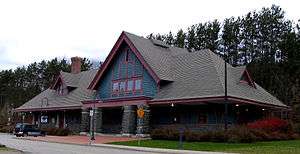
- The Adirondack Regional Airport is 7.3 miles (11.7 km) northwest of the village.[31]
- Adirondack Trailways serves Saranac Lake, and is part of the Greyhound Lines bus system.[32]
- There is also local bus service from Franklin County Public Transportation and local taxi services.[33]
- The Adirondack Scenic Railroad (a seasonal tourist attraction) to Lake Placid originated from the village train depot. Operations were suspended in 2017. There were plans to expand route to Tupper Lake,[34] but the state has decided to instead convert the northernmost 34-miles of rail corridor to a rail trail.[35]
Geography

Saranac Lake is located at 44°19′34″N 74°7′51″W (44.325988, −74.130944).[36]
According to the United States Census Bureau, the village has a total area of 3.0 square miles (7.8 km2), of which 2.8 square miles (7.2 km2) is land and 0.23 square miles (0.6 km2), or 8.21%, is water.[3]
The village is located at the junction of the towns of North Elba and St. Armand in Essex County, and Harrietstown in Franklin County.
The village is at the intersection of New York State Route 3 and New York State Route 86. Essex County Road 33 enters the village from the southeast, and Franklin County Road 47 joins NY-86 immediately north of the village.
The closest major metropolitan city is Montreal, Quebec, Canada, 103 miles (166 km) to the north. Plattsburgh is 50 miles (80 km) to the northeast, Burlington, Vermont, is 69 miles (111 km) by road to the east and Albany is 148 miles (238 km) to the south.
Demographics
| Historical population | |||
|---|---|---|---|
| Census | Pop. | %± | |
| 1880 | 191 | — | |
| 1890 | 768 | 302.1% | |
| 1900 | 2,594 | 237.8% | |
| 1910 | 4,983 | 92.1% | |
| 1920 | 5,174 | 3.8% | |
| 1930 | 8,020 | 55.0% | |
| 1940 | 7,138 | −11.0% | |
| 1950 | 6,913 | −3.2% | |
| 1960 | 6,421 | −7.1% | |
| 1970 | 6,086 | −5.2% | |
| 1980 | 5,578 | −8.3% | |
| 1990 | 5,377 | −3.6% | |
| 2000 | 5,041 | −6.2% | |
| 2010 | 5,406 | 7.2% | |
| Est. 2019 | 5,200 | [2] | −3.8% |
| U.S. Decennial Census[37] | |||

As of the census[38] of 2000, there were 5,041 people, 2,369 households, and 1,182 families residing in the village. The population density was 1,812.0 people per square mile (700.1/km²). There were 2,854 housing units at an average density of 1,025.9 per square mile (396.4/km²). The racial makeup of the village was 96.87% White, 0.75% African American, 0.32% Native American, 0.48% Asian, 0.26% from other races, and 1.33% from two or more races. Hispanic or Latino of any race were 1.07% of the population.
There were 2,369 households out of which 25.4% had children under the age of 18 living with them, 35.2% were married couples living together, 10.3% had a female householder with no husband present, and 50.1% were non-families. 40.7% of all households were made up of individuals and 14.7% had someone living alone who was 65 years of age or older. The average household size was 2.09 and the average family size was 2.88.
In the village, the population was spread out with 22.2% under the age of 18, 11.4% from 18 to 24, 28.3% from 25 to 44, 23.1% from 45 to 64, and 15.0% who were 65 years of age or older. The median age was 38 years. For every 100 females, there were 93.4 males. For every 100 females age 18 and over, there were 90.8 males.
The median income for a household in the village was $29,754, and the median income for a family was $42,153. Males had a median income of $32,188 versus $24,759 for females. The per capita income for the village was $17,590. About 8.5% of families and 13.8% of the population were below the poverty line, including 11.5% of those under age 18 and 17.6% of those age 65 or over.
Sister cities
Saranac Lake has two sister cities:
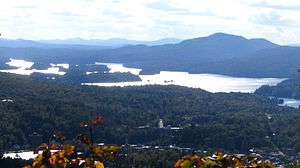
Climate
According to the Köppen climate classification system, Saranac Lake has a Warm-summer, Humid continental climate (Dfb). Dfb climates are characterized by a least one month having an average mean temperature ≤ 32.0 °F (0.0 °C), at least four months with an average mean temperature ≥ 50.0 °F (10.0 °C), all months with an average mean temperature < 71.6 °F (22.0 °C) and no significant precipitation difference between seasons. Although most summer days are comfortably humid in Saranac Lake, episodes of heat and high humidity can occur with heat index values > 89 °F (32 °C). Since 1981, the highest air temperature was 94.7 °F (34.8 °C) on 08/03/1988, and the highest daily average mean dew point was 70.7 °F (21.5 °C) on 08/01/2006. Since 1981, the wettest calendar day was 3.92 inches (100 mm) on 11/08/1996. During the winter months, the average annual extreme minimum air temperature is −27.3 °F (−32.9 °C).[39] Since 1981, the coldest air temperature was −34.9 °F (−37.2 °C) on 01/16/1994. Episodes of extreme cold and wind can occur with wind chill values < −43 °F (−42 °C). The average annual snowfall total (Oct-May) is between 100 inches (254 cm) and 125 inches (318 cm).
| Climate data for Saranac Lake, NY (1981–2010 normals, extremes 1903–present) | |||||||||||||
|---|---|---|---|---|---|---|---|---|---|---|---|---|---|
| Month | Jan | Feb | Mar | Apr | May | Jun | Jul | Aug | Sep | Oct | Nov | Dec | Year |
| Record high °F (°C) | 62 (17) |
65 (18) |
79 (26) |
89 (32) |
94 (34) |
101 (38) |
99 (37) |
97 (36) |
92 (33) |
86 (30) |
75 (24) |
64 (18) |
101 (38) |
| Mean maximum °F (°C) | 47.8 (8.8) |
49.9 (9.9) |
61.9 (16.6) |
75.5 (24.2) |
82.5 (28.1) |
86.6 (30.3) |
87.4 (30.8) |
86.6 (30.3) |
82.1 (27.8) |
74.4 (23.6) |
62.8 (17.1) |
50.1 (10.1) |
89.1 (31.7) |
| Average high °F (°C) | 25.3 (−3.7) |
29.1 (−1.6) |
37.7 (3.2) |
51.4 (10.8) |
64.1 (17.8) |
72.6 (22.6) |
76.6 (24.8) |
75.2 (24.0) |
67.5 (19.7) |
54.6 (12.6) |
41.9 (5.5) |
29.8 (−1.2) |
52.0 (11.1) |
| Daily mean °F (°C) | 14.7 (−9.6) |
16.4 (−8.7) |
25.4 (−3.7) |
39.5 (4.2) |
50.6 (10.3) |
60.3 (15.7) |
64.2 (17.9) |
62.6 (17.0) |
54.8 (12.7) |
43.4 (6.3) |
32.9 (0.5) |
20.3 (−6.5) |
41.5 (5.3) |
| Average low °F (°C) | 3.8 (−15.7) |
4.1 (−15.5) |
13.3 (−10.4) |
27.6 (−2.4) |
37.5 (3.1) |
47.7 (8.7) |
52.0 (11.1) |
50.0 (10.0) |
42.3 (5.7) |
32.8 (0.4) |
23.7 (−4.6) |
11.0 (−11.7) |
29.8 (−1.2) |
| Mean minimum °F (°C) | −23.8 (−31.0) |
−21.2 (−29.6) |
−12.2 (−24.6) |
11.6 (−11.3) |
23.5 (−4.7) |
32.5 (0.3) |
39.0 (3.9) |
35.5 (1.9) |
27.0 (−2.8) |
18.1 (−7.7) |
3.0 (−16.1) |
−15.7 (−26.5) |
−27.1 (−32.8) |
| Record low °F (°C) | −46 (−43) |
−44 (−42) |
−35 (−37) |
−10 (−23) |
10 (−12) |
22 (−6) |
29 (−2) |
27 (−3) |
15 (−9) |
2 (−17) |
−21 (−29) |
−46 (−43) |
−46 (−43) |
| Average precipitation inches (mm) | 2.33 (59) |
1.67 (42) |
2.29 (58) |
2.88 (73) |
3.24 (82) |
3.90 (99) |
3.86 (98) |
3.92 (100) |
3.80 (97) |
3.60 (91) |
3.03 (77) |
2.73 (69) |
36.24 (920) |
| Average snowfall inches (cm) | 27.7 (70) |
21.4 (54) |
18.7 (47) |
9.9 (25) |
1.2 (3.0) |
0.0 (0.0) |
0.0 (0.0) |
0.0 (0.0) |
0.0 (0.0) |
2.8 (7.1) |
15.9 (40) |
24.9 (63) |
119.8 (304) |
| Average precipitation days (≥ 0.01 in.) | 16.6 | 13.2 | 14.9 | 15.3 | 16.0 | 15.3 | 15.3 | 16.4 | 14.8 | 16.0 | 16.7 | 17.9 | 190.2 |
| Average snowy days (≥ 0.1 in.) | 17.1 | 12.9 | 12.1 | 5.8 | 0.8 | 0.0 | 0.0 | 0.0 | 0.1 | 2.1 | 9.8 | 16.6 | 76.7 |
| Source: NOAA[40] | |||||||||||||
Ecology
According to the A. W. Kuchler U.S. potential natural vegetation types, Saranac Lake would have a dominant vegetation type of Northern Hardwoods/Spruce (108) with a dominant vegetation form of Northern Hardwoods (23).[41] The plant hardiness zone is 4a with an average annual extreme minimum air temperature of −27.3 °F (−32.9 °C).[39] The spring bloom typically peaks around May 11 and fall color usually peaks around October 1.
See also
References
- "2019 U.S. Gazetteer Files". United States Census Bureau. Retrieved July 27, 2020.
- "Population and Housing Unit Estimates". United States Census Bureau. May 24, 2020. Retrieved May 27, 2020.
- "Geographic Identifiers: 2010 Demographic Profile Data (G001): Saranac Lake village, New York". U.S. Census Bureau, American Factfinder. Retrieved February 22, 2016.
- "Geographic Identifiers: 2010 Census Summary File 1 (G001), Saranac Lake village (part), Harrietstown town, Franklin County, New York". American FactFinder. U.S. Census Bureau. Archived from the original on February 14, 2020. Retrieved June 13, 2016.
- "Geographic Identifiers: 2010 Census Summary File 1 (G001), Saranac Lake village (part), North Elba town, Essex County, New York". American FactFinder. U.S. Census Bureau. Archived from the original on February 14, 2020. Retrieved June 13, 2016.
- "Geographic Identifiers: 2010 Census Summary File 1 (G001), Saranac Lake village (part), St. Armand town, Essex County, New York". American FactFinder. U.S. Census Bureau. Archived from the original on February 14, 2020. Retrieved June 13, 2016.
- Crampton, Norman, The 100 Best Small Towns in America, Arco, 1995. ISBN 978-0-02-860577-7
- National Trust - Dozen Distinctive Destinations
-
- Chalmers, Stephen (September 1912). "Sanitary Saranac Lake: A Small Town That Has Had Only Seventeen Deaths From Contagious Diseases In Twelve Years". The World's Work: A History of Our Time. XXIV: 581–585. Retrieved 2009-07-10.
- "John R. Booth". Historic Saranac Lake. Retrieved March 14, 2013.
- Gallos, Phillip L. (1985). "Cure Cottages of Saranac Lake", Historic Saranac Lake ISBN 0-9615159-0-2, pp. viii.
- Gallos, Philip, Cure Cottages of Saranac Lake: Architecture and History of a Pioneer Health Resort, Saranac Lake:Historic Saranac Lake, 1985. ISBN 0-9615159-0-2
- "A Brief History of Saranac Lake", pamphlet available at Saranac Lake visitor information center
- Historic Saranac Lake Archived 2010-06-28 at the Wayback Machine
- Taylor, Robert, America's Magic Mountain, Boston: Houghton Mifflin, 1986. ISBN 0-395-37905-9
- Kaplan, Thomas (August 24, 2011). "In Mountain Village, Cuomo Finds Respite". The New York Times. Retrieved August 25, 2011.
- "National Register Information System". National Register of Historic Places. National Park Service. July 9, 2010.
- "National Register of Historic Places". Weekly List of Actions Taken on Properties: 11/19/12 through 11/23/12. National Park Service. 2012-11-30.
- "National Register of Historic Places". Weekly List of Actions Taken on Properties: 10/19/15 through 10/23/15. National Park Service. 2015-10-30.
- "National Register of Historic Places". Weekly List of Actions Taken on Properties: 2/23/15 through 2/27/15. National Park Service. 2015-03-06.
- Tissot, Caperton (2012). Saranac Lake's Ice Palace: history of Winter Carnival's crown jewel (1st ed.). Saranac Lake, NY: Snowy Owl Press. p. 6. ISBN 9780615619613.
- Tissot, p. 12, 24
- "Can Am Rugby Tournament". canamrugby.com.
- "Pendragon Theatre". pendragontheatre.org/.
- "Plein Air Festival". saranaclakeartworks.com.
- "Saranac Lake ArtWorks". saranaclakeartworks.com.
- Suchoff, Benjamin, Béla Bartók: A Celebration, Scarecrow Press, 2004, p. 8
- "Robert Louis Stevenson Museum".
- "Slate: GB Trudeau's Doonesbury".
- Cortese, Amy (November 12, 2011). "A Town Creates its Own Department Store". The New York Times. Retrieved November 14, 2011.
Community ownership seems to resonate in these days of protest.
- "Google maps".
- "Trailways".
- "Yahoo Local".
- "Adirondack Scenic Railroad".
- "APA slates hearings on railroad corridors".
- "US Gazetteer files: 2010, 2000, and 1990". United States Census Bureau. 2011-02-12. Retrieved 2011-04-23.
- "Census of Population and Housing". Census.gov. Retrieved June 4, 2015.
- "U.S. Census website". United States Census Bureau. Retrieved 2008-01-31.
- "USDA Interactive Plant Hardiness Map". United States Department of Agriculture. Retrieved October 9, 2019.
- "NOWData - NOAA Online Weather Data". NOAA. Retrieved July 20, 2020.
- "U.S. Potential Natural Vegetation, Original Kuchler Types, v2.0 (Spatially Adjusted to Correct Geometric Distortions)". Retrieved October 9, 2019.
Further reading
- John J. Duquette (March 1992). John M. Penney (ed.). Saranac Lake, A Centennial: 1892-1992. Make-up by Carol Baker Snyder. Saranac Lake, New York: Saranac Lake 1992 Centennial Committee.
- Maid, Chery (February 7, 2006). "Building boom brought many local landmarks- How the 20s roared in Saranac Lake". Adirondack Enterprise. pp. 1, 9.
- Gallos, Phil (February 8, 2006). "Famous people you might meet on the street- How the 20s roared in Saranac Lake". Adirondack Enterprise. pp. 1, 10.
- Jackson, Linda. "Flaunting the booze ban- How the 20s roared in Saranac Lake". Adirondack Enterprise. pp. 1, 12.
- Gallos, Phillip L. (1985). Cure Cottages of Saranac Lake. Historic Saranac Lake. pp. viii. ISBN 0-9615159-0-2.
External links
| Wikimedia Commons has media related to Saranac Lake, New York. |
| Wikivoyage has a travel guide for Saranac Lake. |
